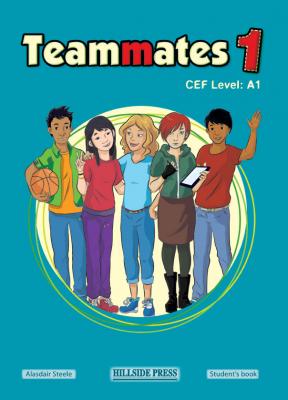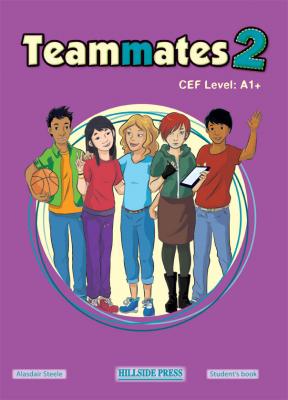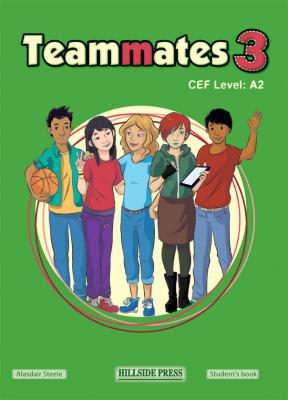A1-A2 / Teammates 1, 2, 3
Teammates 1
TEAMMATES 1 is the first book of the TEAMMATES series. Pupils acquire a basic (Beginner’s) knowledge of the English language with the help of Anna, Diego, Lucy, Masako and Omar, who have never met each other but manage to form an excellent relationship online, and become ‘teammates’.
The Coursebook starts with the “What can you remember?” section, which helps pupils revise their previous knowledge. The Coursebook contains 14 units, each of which is divided into the following sections: online chat, reading text, vocabulary, grammar, skills activities and ‘Around the World’. This clear, consistent structure means that pupils know what to expect and what is expected of them at each stage of every lesson.
Before each set of 3 units, there is a fun page with a song (that introduces pupils to some new vocabulary from the next 3 units), a riddle, a joke and a ‘Wordsnake’ activity that revises previous vocabulary. This page also presents the objectives of the three units that follow.
After each 3-unit set, there is a comic strip story which unfolds in episodes. This is a fun break that motivates students and creates the conditions for further discussion. A revision section and a self-assessment questionnaire follow. These encourage pupils to monitor their progress, take responsibility for their learning and become more aware of any problem areas they may have to work on.
Unit organisation
Each unit has a theme which is of interest to young learners at this level. Pupils find it easier to remember new vocabulary that is presented in context and in themed lexical sets. Every unit begins with an online chat featuring three of the five characters that appear throughout the book. The online chats are based on these characters’ experiences and perspectives. They present pupils with authentic informal functional language. They also act as an introduction to the unit theme and present pupils with examples of the grammar phenomena that they will study in the unit. The online chat is followed by some questions. After pupils listen to or read the online chat, you can use these questions to generate a short class discussion on the theme of the unit. The first page of each unit also features a full-page illustration related to the online chat. These illustrations can be used with pupils to prompt discussion.
The main reading text is on the second page of each unit. The texts may be an online profile, an email, a blog post, a diary entry, a review, an extract from a travel guide, a story, etc. The reading text further develops the theme of the unit and presents pupils with useful vocabulary while exposing them to a variety of writing styles. After the reading text, there are reading comprehension activities that consolidate pupils’ understanding of the text.
The ‘Out and About’ section on the reading text page features material such as adverts, posters, signs and labels that pupils would be likely to encounter if they visited an English-speaking country. Showing pupils that they can understand material such as this boosts their confidence and reminds them of some of the practical benefits of studying English.
The vocabulary section in each unit contains tasks that focus on the new vocabulary presented in the online chat, reading text and ‘Out and About’ section. Further useful vocabulary connected with the unit theme is presented in the Extra! vocabulary boxes. The introduction of new vocabulary is carefully controlled and recycled throughout the course to reinforce pupils’ understanding of these lexical items.
The unit grammar is presented in clear concise tables at the top of the grammar page in each unit. These grammar phenomena are explained in more detail in the Grammar Appendix at the back of the book. The grammar tasks have been designed to reinforce pupils’ understanding and increase their confidence in using all the grammar structures they need at this level. There are further grammar tasks in the Workbook and on the e-book.
It is very important for young learners to get plenty of practice in speaking English, in order for them to develop fluency and gain confidence. Pupils are given the opportunity to talk to the teacher, in pairs and in larger groups at various points throughout the units. The activities in the speaking sections are designed to encourage pupils to speak spontaneously, using the vocabulary and/or grammar that they have just learnt. These activities often take the form of a game so that pupils feel under less pressure, have fun and come to enjoy communicating in English. Each unit also has a pronunciation task (on the speaking page), which gives pupils the opportunity to listen to and practise pronouncing words that contain sounds non-native speakers of English often have problems with.
The listening section in each unit contains one or more activities. Pupils practise their listening skills when they hear the recordings of the online chats and the reading texts. However, it is also important for them to learn to recognise and understand English that is heard but not seen. This course contains a variety of types of listening activity which will improve pupils’ comprehension skills. The listening activities utilise the vocabulary and/or grammar presented in the unit and thus further consolidate pupils’ understanding.
Young learners often lack confidence when it comes to producing longer pieces of written English. The writing activity in each unit provides pupils with the regular practice that they need. Plans, sample compositions and tasks are used to guide pupils through the writing activities, making sure that they have all the help they need and understand exactly what is expected of them. During the course, pupils produce a variety of types of writing, which further recycles and reinforces the language they have learnt.
At the end of the book, there is also a glossary that presents the words for every unit thematically (in alphabetical order), and a list of irregular verbs.
Teammates 2
TEAMMATES 2 is the second book of the TEAMMATES series. The aim of this level is to consolidate the beginner’s knowledge pupils acquired the previous year and prepare them for the elementary level that they will complete the following year.
The characters Anna, Diego, Lucy, Masako and Omar who are featured throughout the book will already be familiar to students from the first book in the series. They discuss problems and concerns relevant to students of this age and introduce students to useful everyday English.
The Coursebook starts with the “What can you remember?” section, which helps pupils, revise their previous knowledge. The Coursebook contains 14 units, each of which is divided into the following sections: online chat or dialogue, reading text, “Out and About”, vocabulary, grammar, speaking, listening, writing and “Around the World”. This clear, consistent structure means that pupils know what to expect and what is expected of them at each stage of every lesson.
Before each set of 3 units, there is a fun page with a song, a riddle, a joke and a fun activity that presents some of the new vocabulary. This page also presents the objectives of the three units that follow.
After each 3-unit set, there is a comic strip story which unfolds in episodes. This is a fun break that motivates students and creates the conditions for further discussion. A revision section and a self-assessment questionnaire follow. These encourage pupils to monitor their progress, take responsibility for their learning and become more aware of any problem areas they may have to work on.
Unit organisation
Online chat or dialogue: every unit begins with an online chat featuring three of the five characters that appear throughout the book. The online chats are based on these characters’ experiences and perspectives. They present pupils with authentic informal functional language. They also act as an introduction to the unit theme and present pupils with examples of the grammar phenomena that they will study in the unit. The online chat is followed by some questions. After pupils listen to or read the online chat, you can use these questions to generate a short class discussion on the theme of the unit. The first page of each unit also features a full-page illustration related to the online chat. These illustrations can be used with pupils to prompt discussion.
Main reading text: the texts may be an online profile, an email, a blog post, a diary entry, a review, an extract from a travel guide, a story, etc. The reading text further develops the theme of the unit and presents pupils with useful vocabulary while exposing them to a variety of writing styles. After the reading text, there are reading comprehension activities that consolidate pupils’ understanding of the text.
“Out and About”: This section features material such as adverts, posters, signs and labels that pupils would be likely to encounter if they visited an English-speaking country. Showing pupils that they can understand material such as this boosts their confidence and reminds them of some of the practical benefits of studying English.
Vocabulary: this section contains tasks that focus on the new vocabulary presented in the online chat, reading text and ‘Out and About’ section. Further useful vocabulary connected with the unit theme is presented in the Extra! vocabulary boxes. The introduction of new vocabulary is carefully controlled and recycled throughout the course to reinforce pupils’ understanding of these lexical items.
Grammar: the unit grammar is presented in clear concise tables at the top of the grammar page in each unit. These grammar phenomena are explained in more detail in the Grammar Appendix at the back of the book. The grammar tasks have been designed to reinforce pupils’ understanding and increase their confidence in using all the grammar structures they need at this level. There are further grammar tasks in the Workbook and on the e-book.
Speaking: Pupils are given the opportunity to talk to the teacher, in pairs and in larger groups at various points throughout the units. The activities in the speaking sections are designed to encourage pupils to speak spontaneously, using the vocabulary and/or grammar that they have just learnt. These activities often take the form of a game so that pupils feel under less pressure, have fun and come to enjoy communicating in English. Each unit also has a pronunciation task, which gives pupils the opportunity to listen to and practise pronouncing words that contain sounds non-native speakers of English often have problems with.
Listening: The listening section in each unit contains a variety of types of listening activity which will improve pupils’ comprehension skills. The listening activities utilise the vocabulary and/or grammar presented in the unit and thus further consolidate pupils’ understanding.
Writing: The writing activity in each unit provides pupils with the regular practice that they need. Plans, sample compositions and tasks are used to guide pupils through the writing activities, making sure that they have all the help they need and understand exactly what is expected of them. During the course, pupils produce a variety of types of writing, which further recycles and reinforces the language they have learnt.
“Around the world”: This section of each unit utilises a more cross-curricular approach to learning English, which touches on many aspects of life and culture.
At the end of the book, there is also a glossary that presents the words for every unit thematically (in alphabetical order), and a list of irregular verbs.
Teammates 3
TEAMMATES 3, which is the third book of the TEAMMATES series, aims to develop pupils’ knowledge of English to A2 level in accordance with the Common European Framework of Reference for languages.
The characters Anna, Diego, Lucy, Masako and Omar, who are featured throughout the book and are already familiar to pupils from the first two books in the series, all meet in person for the first time and spend four whole months together in Liverpool. Your pupils’ English will improve as they share our characters’ adventures and problems.
The Coursebook starts with the “What can you remember?” section, with tasks that help pupils remember what they learnt in previous years. It continues with four sets of three units (comprising twelve 8-page units in total), each of which has the following structure:
Online chat or dialogue
Thinking about...
Authentic text (Out and About)
Main reading text with comprehension questions
Vocabulary and Extra Vocabulary
Grammar
Speaking
Listening
Writing
Before each set of 3 units, there is a fun page with a song, a riddle, a joke and a fun activity that presents some of the new vocabulary. This page also presents the objectives of the three units that follow.
After each 3-unit set, there is a comic strip story which unfolds in episodes. This is a fun break that motivates students and creates the conditions for further discussion. A revision section and a self-assessment questionnaire follow. These encourage pupils to monitor their progress, take responsibility for their learning and become more aware of any problem areas they may have to work on.
Unit organisation
Online chat or dialogue: our characters describe their daily lives using authentic informal language through which the vocabulary and grammar phenomena of that particular unit will be taught. The comprehension questions and the illustrations are designed to prompt class discussion.
Thinking about: this section on the second page of each unit gives pupils some prompts, encouraging them to continue the discussion of the unit theme. (Το τμήμα αυτό δίνει στους μαθητές να συνεχίσουν και να εμβαθύνουν τη συζήτηση στην τάξη σχετικά με την ευρύτερη θεματική του κεφαλαίου μέσα από διαφορετικού τύπου δραστηριότητες (γραφήματα, ερωτηματολόγια, κουί, φωτογραφίες, κ.λπ.)
Out and About: This section features material such as adverts, posters, signs and labels that pupils would be likely to encounter if they visited an English-speaking country. Showing pupils that they can understand material such as this boosts their confidence and reminds them of some of the practical benefits of studying English.
Main reading text: the texts may be an online profile, an email, a blog post, a diary entry, a review, an extract from a travel guide, a story, etc. The reading text exposes pupils to useful vocabulary and a variety of writing styles. It is followed by reading comprehension tasks to consolidate pupils’ understanding.
Vocabulary: this section contains tasks that focus on the new vocabulary presented in each text of the unit. Further useful vocabulary linked to the theme of the unit is presented in the Extra! vocabulary boxes. The introduction of new vocabulary is carefully controlled and recycled throughout the course to reinforce pupils’ understanding of these lexical items.
Grammar: the unit grammar is presented in clear concise tables below the Extra! vocabulary in each unit. These grammar phenomena are explained in more detail in the Grammar Appendix at the back of the book. The grammar tasks have been designed to reinforce pupils’ understanding and increase their confidence in using all the grammar structures they need at this level. There are further grammar tasks in the Workbook and on the e-book.
Speaking: Pupils are given the opportunity to talk to the teacher, in pairs and in larger groups at various points throughout the units. The activities in the speaking sections are designed to encourage pupils to speak spontaneously, using the vocabulary and/or grammar that they have just learnt. These activities often take the form of a game so that pupils feel under less pressure, have fun and come to enjoy communicating in English. Each unit also has a pronunciation task, which gives pupils the opportunity to listen to and practise pronouncing words that contain sounds non-native speakers of English often have problems with.
Listening: The listening section in each unit contains a variety of types of listening activity which will improve pupils’ comprehension skills. The listening activities utilise the vocabulary and/or grammar presented in the unit and thus further consolidate pupils’ understanding.
Writing: The TEAMMATES series put a special emphasis on the development of student's writing skills. A whole page with writing activities in each unit provides pupils with the regular practice that they need. Plans, sample compositions and tasks are used to guide pupils through the writing activities, making sure that they have all the help they need and understand exactly what is expected of them. During the course, pupils produce a variety of types of writing, which further recycles and reinforces the language they have learnt.
At the back of the book, there is also a glossary that presents the words for every unit thematically (in alphabetical order), and a list of irregular verbs.



